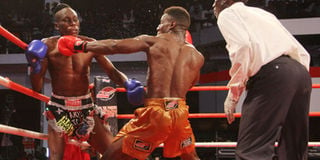Understanding kickboxing

Golola beat Mugula in the most recent high profile fight. Photo by I. KEZAALA
Kampala.
To many Ugandan kickboxing fan, fighting styles and rules don’t matter and if they do they rank least on their list.
All they do is throng the fight arena in droves and pour out their passion for their favourite fighters.
Just like other sports disciplines, kick boxing has different arts and fighting styles.
In the second article of the four series on kickboxing, SCORE’s Abdu Wasike digs deep into the sport’s technical bit explaining in detail its styles and rules.
According to Eddie Gombya, the Uganda Kickboxing Federation general secretary, kickboxing rules change basing on the style chosen by both fighters.
“Kickboxing has no proper rules,” he admitted. “They keep changing considering the adopted style.”
Explaining further Gombya says; “Muay Thai kickboxing rules are different from full contact, low kick and K-1. But good enough, all the styles are approved by the World kickboxing Federation (WKF) and we have all the rules of every style.”
What’s kickboxing?
The term kickboxing is a somewhat generic one used to cover the combination of several different striking or stand up fighting styles that fall within the classification of sport martial arts.
Though the term kickboxing was specifically initiated in Japan and evolved from full contact karate, its history and roots are in many ways tied to the Thailand martial art of Muay Thai Boxing as well.
The sport of kickboxing often takes place in a ring where combatants, depending on the style of kickboxing being practiced, may utilise kicks, punches, elbow strikes, head-butt’s, knee strikes, and throws against one another.
Here is a run-down of the main types of kickboxing styles, according to the World Kickboxing Federation competition book submitted to this newspaper by Uganda Kickboxing Federation.
Muay Thai (Thai boxing): Is a combat sport from the Muay martial arts of Thailand that uses stand-up striking along with various clinching techniques. This physical and mental discipline which includes combat on foot is known as ‘the art of eight weapons’ because it is characterised by the combined use of fists, elbows, knees, shins and feet, being associated with a good physical preparation that makes a fight efficient.
K1 – Kick Boxing: In this style, which is familiar in Uganda, a kickboxer combines techniques from Karate, Kung Fu, Muay Thai, Boxing and other stand up martial arts to work towards a universal martial art.
Full contact kickboxing: In this style you combine Western boxing and traditional karate techniques. It’s distinguished in dress from other forms of kickboxing. Long pants and foot pads are mandatory.
Adithada (Indian Style kickboxing): In this type of kickboxing you use primarily the knee, elbow and forehead strikes.
Cardio Kickboxing (exercise based): A form of kickboxing geared towards keeping fit.
Lethwei (Burmese kickboxing): This is the traditional Burmese martial art. Now days it is fast becoming a main kick boxing event. Here boxers are allowed to head-butt as a form of attack. The boxer is allowed to use any limb or part of the body to strike, and can land a strike on any part of the opponents body. No area is off limits. This type is also known as Bando kickboxing.
Pradal Serey (Khmer ‘Cambodian’ kickboxing): This is allegedly the predecessor of Muay Thai. Pradal Serey has strong emphasis on using different elbow attacks.
Gwon-Gyokdo (Korean kickboxing): That is a mash up between the two main types of kick boxing, mainly Tae Kwon Do and Muay Thai. It is generally practised in Korea and is also known as ‘Kyuk Too Ki’.
Muay Boran (Ancient Boxing): This was the predecessor of Muay Thai. It is like Pradal Serey where the use of head-butts and is allowed.
Japanese kickboxing: In ways this is comparable to Muay Thai. The main difference is in competition, where a different points system is used. This was the first fighting style to adopt the name of ‘Kickboxing’.
American kickboxing: The main difference here is that one is not allowed to kick any region below the waist.
Savate (French kickboxing): Here boxers are allowed to wear shoes in competition. This allows boxers to land more deadly kicks.
Sanshou/Sanda (Chinese kickboxing): This is similar to wushu/kung fu. Here throws are an integral part of sparring, so boxers are allowed to physical grab hold of their opponent to land them on their back.
Shoot kickboxing: This is a Japanese form of kickboxing. It is similar to Sanshou/Sanda, where the boxers are also allowed to perform throws. The main stipulation is that the kickboxer needs to be standing when doing this.
Yaw-Yan (Filipino kickboxing): Here kicks are generally in a downward direction, like a chop down to bring the user to the floor. It also has a big emphasis on hip pivoting to generate more speed and strength. Most Ugandans fighters specialise in the K-1 and low kick styles.
styles
Moses Golola: K-1 and Low kick
Titus Tugume: Full contact and Low kick
Ronald Mugula: Low kick and K-1
John Tumukunde: Full contact and Low kick
Malik Kaliisa: Full contact
Umar Semata: Low kick, K-1 and Muay Thai.
Sharif Bukenya: Full contact and Low kick




